Living in Space
Designed for: Grades K-8 For use by:
Students, Teachers.
Learning Styles: Classroom based
Resource Type: Document
To travel in space the basic requirements for human survival are exactly the same as those requirements on Earth – air, water and food. A human needs a balanced diet containing enough energy for each day’s activities, and a suitable environment.
Energy for humans
A totally sedentary human needs a minimum of about 2000 Calories of food energy per day in order to survive (plus small, but essential, amounts of vitamins and minerals).
One food Calorie (with a capital “C”) is actually equal to 1000 calories of heat energy (i.e. 1 Cal = 1kcal) Calories are fine for comparing the energy content of food products but not really very useful for scientific work. For scientific applications we use an energy unit called the joule (J).
1Cal = 4.2kJ
We can calculate that a human needs about 2000 x 4.2 kJ of energy, or about 8.4 MJ per day
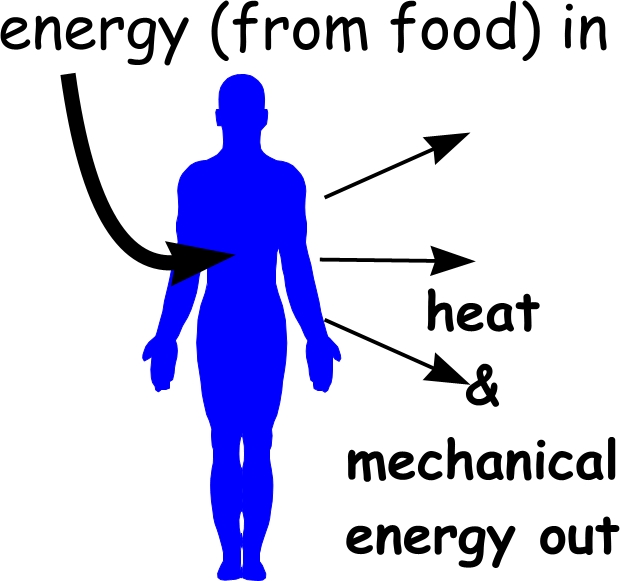
A balanced diet with enough kilojoules
A balanced diet is one that contains the following:
- Water
- Sufficient kilojoules of energy, primarily from carbohydrates
- Proteins
- Carbohydrates
- Fats – Essential for metabolizing some vitamins as well as to provide “stored” energy
- Vitamins
- Mineral salts
- Fiber
You can view the Dietary Guidelines for Americans 2015 – 2020 and, if you wish, you can download the full document or focus on specific aspects. There is much to be learned about the nutritional value of foods, and using space travel and the foods that are eaten and can be grown may have significant impact on students’ eating habits.
How many kilojoules does a person need each day?
The answer depends upon three factors:
- One’s basal metabolic rate (BMR)
- The level of physical activity undertaken during the day
- The environmental temperature
Basal metabolic rate (BMR)
The basal metabolic rate is the rate of metabolism of a resting individual and is determined by the rate of oxygen consumption. The BMR depends upon the species, age and sex of the individual. In general, BMR decreases gradually as we grow older. At any given age females tend to have a lower BMR than males.

Aerobic Respiration: An important by-product of respiration is the release of energy, mostly as heat. One’s BMR is a measure of the rate at which energy is expended (kilojoules “burned”) while resting. Vigorous activity such as running, or physical work, increases our metabolic rate. The need for more oxygen, and to expel excess carbon dioxide, causes us to “pant”.
Daily energy requirements due to activity
The chart below shows some typical daily energy requirements for humans. An astronaut requires about 14 000-15 000 kJ per day (depending upon the work schedule).
| Category | Energy (kJ) per day |
| Babies less than 2 months old | 2000 |
| Pre-school children (both sexes) | 5000-6000 |
| Teenage (female) | 9000-10000 |
| Teenage (male) | 11000-14000 |
| Adult (sleeping BMR) | 1500-2500 |
| Adult (clerical) | 10000-12000 |
| Astronaut (shuttle) | 14000-15000 |
| Adult (construction) | 14000-16000 |
Temperature considerations
Humans, like all mammals, are warm blooded and need to maintain a constant body temperature in order to survive. Ideal body temperature varies slightly from mammal to mammal, but for humans it is 37 o C. Or 98.6 o F. Deviations of more than few degrees from this temperature within the body core (chest cavity) are dangerous. We get “chills” and shiver, or we get hot and feverish.
Placed in a cold environment the body responds by increasing its basal metabolism, thereby generating more heat. Arctic and Antarctic travelers require a much higher kilojoule intake than travelers in more temperate climates, doing the same amount of work.
A suitable environment
The conditions for a suitable environment include:
- air to breathe, containing oxygen, water vapor and relatively free of carbon dioxide and other gases, except for nitrogen or inert (non-reactive) gases such as argon and helium.
- a suitable temperature, ideally about 20o-22°C (68 o F – 71.6 o F)
- protection from external hazards.
- sufficient space for both physical and psychological comfort.
- suitable lighting.
Carbon dioxide, oxygen, and water vapor
In short-term missions into space the problem of maintaining a suitable atmosphere is generated simply by removing unwanted gases and adding oxygen as required, then recirculating the air. All waste materials are discarded when the mission returns to Earth. You can learn more about some of the efforts to recycle waste on the NASA website.
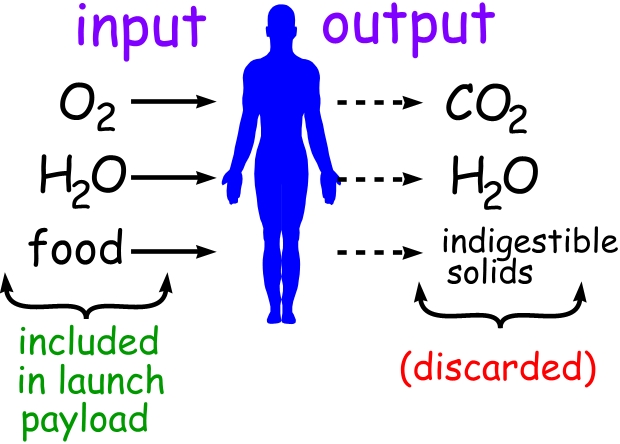
For long-term missions the problem is much harder to deal with, since one cannot easily travel with an unlimited supply of gas filters, water, food, or oxygen. Water vapor also creates a problem. If the air is too dry it is uncomfortable to breathe for long periods. If the air is too moist condensation occurs in cold places creating possible corrosion and electrical problems.
Plants (given sufficient light) will consume carbon dioxide. In either a space vehicle, or a planet-based habitat, green plants may be used to help manage air quality.
The release of oxygen and the reduction of carbon dioxide are extremely helpful in maintaining a comfortable and healthy atmosphere within a closed environment.
The cycle below does not appear complete, since carbon (C) seems to disappear into the plant. To make the cycle truly complete, the human would eat the fruit from the plant, thereby completing the cycle of carbon (in carbohydrates).
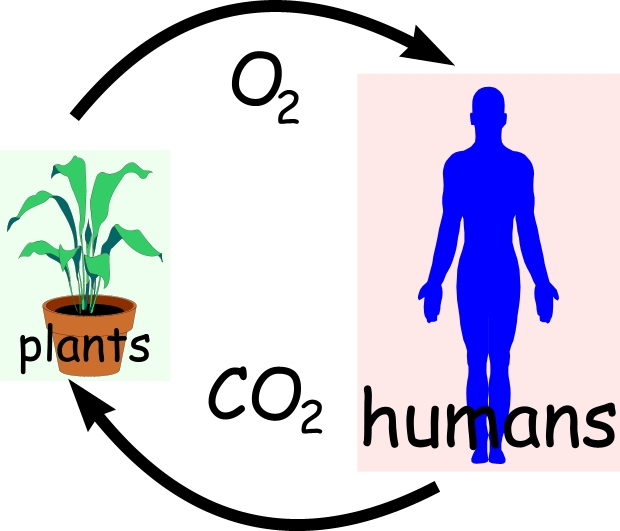
In addition to consuming carbon dioxide during photosynthesis, green plants also produce water vapor. A moderate amount of water vapor is important in creating a comfortable environment. Equally important is the fact that the water vapor – which plants yield to the air through the process of transpiration, is pure. Condensing this water vapor produces clean drinking water, even when the plants are watered with impure water. It may be possible to use plants to facilitate the purification of human waste water.
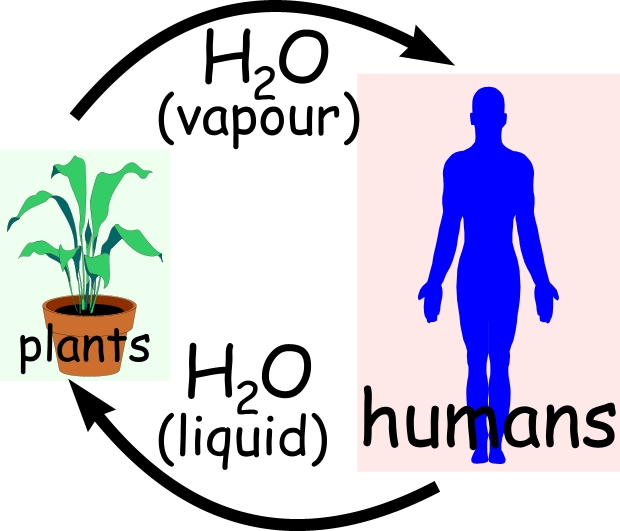
Summary
A complete recycling of resources is shown below. In a perfect system, oxygen and food would be produced at a rate that balances the consumption of carbon dioxide and water (a state of dynamic equilibrium). To make the system function, however, energy must flow through the system, entering as light and eventually emerging as heat.
Note: chemical formulae are used as abbreviations only. The chemical process is not balanced.
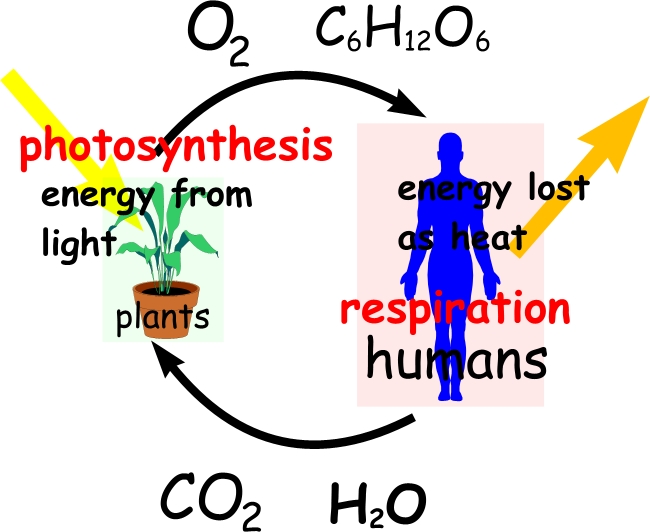
There are two associated student activities related to this section. The first deals with an astronaut’s menu and the second deals with an investigation of the role of water vapor in the creation of a comfortable environment … assisting with the establishment of a “closed environment system”. Both can be accessed in the Classroom Curriculum Documents.
Living in Space This Resource is part of the
This Resource is part of the